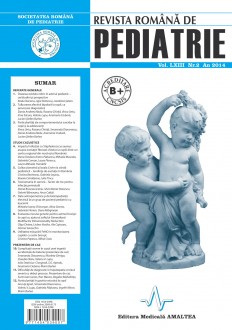SELECT ISSUE

Indexed

| |

|
|
|
| |
|
|
|

|
|
|
|
|
|
|
HIGHLIGHTS
National Awards “Science and Research”
NEW! RJP has announced the annually National Award for "Science and Research" for the best scientific articles published throughout the year in the official journal.
Read the Recommendations for the Conduct, Reporting, Editing, and Publication of Scholarly work in Medical Journals.
The published medical research literature is a global public good. Medical journal editors have a social responsibility to promote global health by publishing, whenever possible, research that furthers health worldwide.
ANTROPOMETRIC AND BIOIMPEDANCE DATA IN A GROUP OF PEDIATRIC PATIENTS WITH LEUKEMIA
Mihaela-Ioana Chincesan, Alina Grama, Gabriela Florian and Oana Marginean
ABSTRACT
Introduction. Poor nutritional status is a common problem among children with malignant disease. In order to detect changes in nutritional status and body composition this study investigates anthropometrical parameters and body composition among pediatric patients with leukemia.
Material and methods. The prospective study included 33 patients hospitalized in Pediatric Clinic No I TgMures who were divided in two groups: group I-study group, patients with leukemia (15 patients) and group IIthe control group consisting of 18 patients with different pediatric diseases. The anthropometric parameters [weight-W, height-H, body mass index (BMI), middle upper arm circumference (MUAC), tricipital skinfold thickness (TST)] were comparatively evaluated. Fat mass (FM, kg and %), fat free mass (FFM, kg), muscle mass (MM, kg) and total body water (TBW, %) were measured in the both group using Tanita BC 420 S MA Analyzer.
Results. Anthropometric parameters in Group I were significantly different from those in Group II for MUAC and TST (p < 0.05). In the study group, FM was much lower (14.79 ± 7.14%) compared with controls (21.56 ± 9.06%) (p = 0.01) and TBW was much higher (61.84 ± 4.93% versus 57.45 ± 6.64%) (p = 0.02). FFM and MM were not statistically different in the two groups.
Conclusion. Bioelectrical impedance analysis in conjunction with arm anthropometry is a sensitive method to detect alteration of body composition in children with malignancy. Compared with the control group, children with leukemia had higher alterations of nutritional status
Keywords: electrical bioimpedance, anthropometry, children, leukemia
